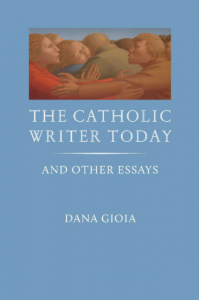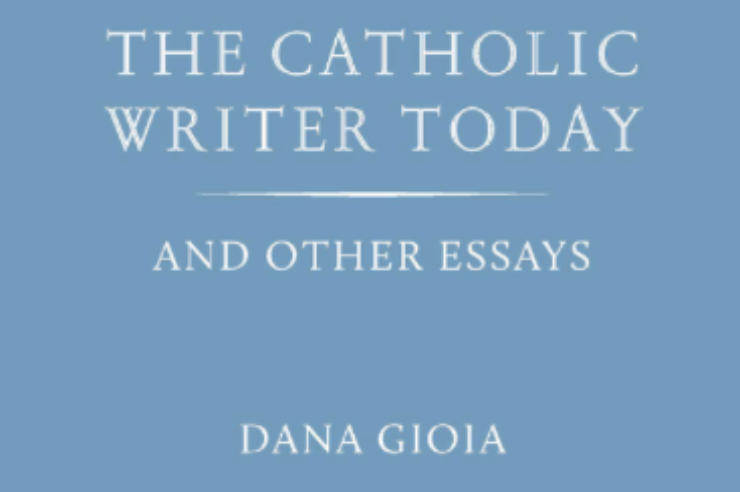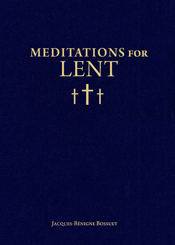Midway through the title essay of The Catholic Writer Today, Dana Gioia writes, “By now I have surely said something to depress, anger or offend every reader of this essay.”
 Gioia is probably correct in that assessment. But I find great hope in his candor and analysis of a complicated problem: “…the paradox that, although Roman Catholicism constitutes the largest religious and cultural group in the United States, Catholicism currently enjoys almost no positive presence in the American fine arts—not in literature, music, sculpture or painting.”
Gioia is probably correct in that assessment. But I find great hope in his candor and analysis of a complicated problem: “…the paradox that, although Roman Catholicism constitutes the largest religious and cultural group in the United States, Catholicism currently enjoys almost no positive presence in the American fine arts—not in literature, music, sculpture or painting.”
While his original title essay was published in 2013, Gioia’s observations ring true today, spurring discussion, and causing the reader to evaluate Catholic literature and publishing in a new light.
Gioia doesn’t pull any punches. He focuses on writers who are practicing Catholics more than those who are only culturally Catholic, while acknowledging that, “In art, a flawed genius can produce a perfect masterpiece, even a religious one.” Comparing the significant number of national awards given to Catholic authors between 1945 and 1965 (11 Pulitzer Prizes and 5 National Book Awards) with the state of current Catholic writers, he says, “Today the cultural establishment views faithful Catholics with suspicion, disdain, or condescension…Anti-Catholicism has grown measurably worse among academics and intellectuals over the past decade…This trend has been aggravated by the many Catholic colleges and universities that now seem socially embarrassed by their religious identity.”
But Gioia concludes that “…to solve a problem, we must first look at it honestly and not minimize or deny the difficulties it presents” and “for the artist, every problem represents a sort of opportunity.”
Most people cannot even identify a major living Catholic writer, Gioia says, which I’m sure is true. What’s not as clear is the reason for this. Is it (1) because there are no Catholic writers producing good work today, (2) that there are difficulties with publishing, promoting, selling and distributing the good work being created, or (3) a combination of the two?
Barriers-to-entry
From an economic standpoint, barriers-to-entry are obstacles that prevent potential competitors from entering an industry. For example, if you want to start an airline, the significant capital needed purchase planes would be a barrier to entry. If you need a retail permit to open a store and those permits take two years to acquire, the lack of a permit is a barrier to entry. What Gioia describes are the many cultural barriers-to-entry that prevent Catholic writers from entering the cultural conversation. These cultural barriers-to-entry and gatekeepers were significant when Gioia first wrote the essay but there is hope for the future as some of those barriers are beginning to fade and will continue to do so.
Writing vs. publishing
We should not confuse the Catholic writer with the Catholic or secular publisher. There is a significant difference between writing (the creation of literature) and publishing (the process of packaging and selling literature). While interdependent, they are separate processes with distinct goals—one attempts to create beauty while the other convinces people to exchange cash for a literary product. The fact that a book doesn’t sell is no indication of its beauty anymore than a book becoming a best-seller assures that it is beautiful. But we often confuse the two, especially with the influence of a secular culture that equates fame with beauty. There is nothing stopping today’s Catholic writers from creating beautiful work, but there is no guarantee there is a hungry market waiting to consume what they’ve created. The market wants what the market wants, and there is no accounting for taste.
This comparison of writing and publishing reminds me of Mark Twain’s short story, Captain Stormfield’s Visit to Heaven, in which there is a discussion of a great poet whose writing was not appreciated while he was alive.
“That is the heavenly justice of it—they warn’t rewarded according to their deserts, on earth, but here they get their rightful rank. That tailor Billings, from Tennessee, wrote poetry that Homer and Shakespeare couldn’t begin to come up to; but nobody would print it, nobody read it but his neighbors, an ignorant lot, and they laughed at it. Whenever the village had a drunken frolic and a dance, they would drag him in and crown him with cabbage leaves, and pretend to bow down to him; and one night when he was sick and nearly starved to death, they had him out and crowned him, and then they rode him on a rail about the village, and everybody followed along, beating tin pans and yelling. Well, he died before morning. He wasn’t ever expecting to go to heaven, much less that there was going to be any fuss made over him, so I reckon he was a good deal surprised when the reception broke on him.”
Whether “that tailor Billings” was posthumously appreciated was not revealed in Twain’s story. But there is a long list of authors including Melville, Dickinson, Poe, Keats and John Kennedy Toole, whose work was not appreciated while they were living.
Gioia builds a solid case for the cultural barriers Catholic writers face. I share his analytical nature. We are both members of “Poets with Masters in Business Administration degrees,” a club with few members. The economics of the problem intrigue me, as do the possible solutions. So in response to his conclusion that, “The renewal of Catholic literature will happen—or fail to happen—through the efforts of Catholic writers,” allow me to share a few thoughts that build upon Gioia’s expert analysis.
The barrier of reading formats
Catholic readers are no different in their reading habits than the general population. Along with the cultural changes Gioia describes, there have been concurrent changes in reading habits. At one time, the only way to consume a book was to purchase a print edition at a bookstore. Today many alternatives exist that benefit the Catholic writer.
According to a Pew research study, Americans read a median number of four books per year, with the average being 12 books. This is largely unchanged since 2011. What has changed, and continues to change, is how those books are consumed.
A recent Association of American Publishers report said that “Downloaded audio remained the fastest growing format, with 28.7% year-over-year revenue growth from 2017 to 2018 and 181.8% revenue growth over the past five years (2014 – 2018).” Within online retail channels, approximately 25% of sales were ebooks and 14% downloaded audiobooks. Thirty-nine percent isn’t something that can be ignored. Most people read a combination of print and ebooks, with only 39% saying they read only print books and 7% saying they read only digital books.
Also according to the Pew study, there are significant age differences. Eighty-four percent of people age 18 to 29 read at least one book in the past 12 months, while only 71% of 50- to 64-year-olds had done so. But the younger cohort was significantly more likely to have read an ebook or audiobook, with 34% having read an ebook in the past 12 months and 23% listening to an audiobook. Those percentages were 20% and 15% respectively for the older cohort.
A larger research study by the National Endowment for the Arts showed similar results, with 50% of 18- to 29-year-olds having read a digital book in the past 12 months, and 41% of 50- to 64-year-olds doing the same. Twenty percent of 18- to 29-year-olds had listened to an audio book, with only 16% of 50- to 64-year-olds listening to one.
Of interest is that ebook and audiobook formats do not require a brick and mortar store to be purchased. In fact, it would seem silly to travel to a physical location to download a file to your phone or iPad. Even libraries today remotely serve many of their patrons with ebooks and audiobooks.
While some Catholic publishers do not yet have significant sales of ebooks and audiobooks, many publishers do. For example, approximately 44% of adult fiction is currently sold in ebook formats. Artificial intelligence technologies are being developed that would allow a publisher or author to automatically convert the text of a book into computer narration that is indistinguishable from a real human voice. There will be a time when readers not only decide the book to which they’d like to listen but also who narrates the book. We’re already seeing some of this technology at work in deepfake videos that use artificial intelligence to transform existing video and voice into new creations that are difficult to distinguish from reality.
I found it ironic that Wiseblood Books, the publisher of Gioia’s book, only offers it in hardcover and paperback formats on Amazon, not as an ebook. While publishers may say that their customers prefer hardcopy editions, that is only because their existing customers do so, not because there isn’t a larger market for ebooks. If we want to reach younger readers, offering books in multiple formats is a good place to start.
The bottom line is that Catholic writers cannot expect to reach wider audiences without embracing the new technologies and book formats that readers expect and prefer. Creating a high-quality book is difficult enough without limiting its potential market.
The barrier of publishing access
There was a time when editors at publishing houses were the gatekeepers for all new books. Authors could not easily publish books on their own. Today, however, there are few barriers-to-entry for the author who wants to self-publish. Certainly there’s much more work involved, including time and money, but the potential financial return is greater, too. This isn’t to say self-publishing is for everyone, but the gatekeepers Gioia mentions are fading in their ability to keep an author from entering the marketplace.
Self-publishing a book on Amazon is free and allows authors to sell where more than half of all books in the United States are purchased. It also allows authors to effortlessly make their titles available around the world.
According to Bowker, “self-publishing grew at a rate of more than 28 percent in 2017, up from an 8 percent increase during the prior year. The total number of self-published titles grew from 786,935 to 1,009,188, surpassing the million mark for the first time.” Whether those books are of good quality is another question but there are fewer gatekeepers who can hold back the Catholic author. Companies such as Reedsy are springing up to help connect indie authors to freelance editors, designers and marketers.
Perhaps the greatest barrier to self-publishing has been the stigma that only authors who cannot get a traditional publishing deal consider self-publishing options. That view is quickly fading as many authors go back and forth between traditional and self-publishing depending on the title and genre. I’ve published four books; two traditionally and two self-published, and see the pros and cons to each method. But regardless of your preference, publishing gatekeepers should not be a significant barrier-to-entry for today’s Catholic writers.
Financial barriers
Traditional book publishing has always been a mysterious business. The truth is that neither authors nor publishers have ever really been able to exactly predict what the market wants. Educated guesses are made but surprises are routine. Most books don’t earn-out their author advance unless the advance is small. (An advance is a lump-sum paid to the author before a book is published against which future royalty payments are charged. If, for example, an author was paid a $1,000 advance and was to receive royalties of $1 per book sold, the author would have to wait until 1,000 copies were sold before receiving any additional royalty payments.)
Publishers survive on a handful of best-sellers and their backlists. They roll the dice on a range of new titles, put some promotion behind those titles and wait to see what rises to the top. It’s a gamblers’ profession and the payouts typically aren’t huge.
This traditional publishing model has always been problematic for two reasons. First, the best way for an author to make more money is to write another book, not to promote an existing one. There is no financial return until the advance has been earned-out and even after it is earned-out, the royalties per copy sold tend not to be worth a lot of time or effort. It’s more financially lucrative to move on to the next book project and the next advance.
Second, if a title doesn’t sell well right away, there is little incentive for the publisher to stick with promoting it except as part of its backlist. Moving on to a new set of titles that are already in the pipeline is easier and more profitable, as there may be some best-sellers among them.
Many good books languish because authors and publishers are not patient enough with them. Sometimes a book needs to be reworked, repackaged and re-released before it becomes successful, but that isn’t how the publishing process has traditionally worked. Cover design, for example, can make or break a title. Many authors don’t realize the intent of the cover is to get potential readers to pick up a book or “look inside” on Amazon. The goal of the cover is not to be an art piece—a book cover is packaging in the same way a cereal box is packaging.
Perhaps the most important thing self-publishing provides the author is financial incentive to continue promoting a title until it gets legs, even if it takes several years to do so. Tools such as Amazon and BookBub advertising allow an author to cost-effectively promote his or her books. Hybrid publishing models that combine the strengths of publishers and authors are needed, especially when the author is willing to share financial risk with the publisher.
Financial patrons are another old idea that is new again. In The Imaginative Conservative article, “Beauty in the Face of Indifference,” Joseph Pearce writes, “The problem is not a lack of talent, nor a lack of good, new and beautiful works of literature; the problem is the woeful indifference towards such beauty on the part of those who could and should be helping to nurture and nourish the literary revival with their practical support.”
The idea of literary patrons is returning through businesses such as Patreon.com, an online service that “powers membership businesses for creators by giving them the tools they need to acquire, manage, and energize their paying patrons.” Since it was founded in 2013, Patron has attracted more than 100,000 creators who are supported by more than 3 million patrons, and is on track to pay creators $1 billion by the end of this year. This is one more way financial barriers-to-entry are falling.
Barriers of access to information
In the past, authors had to rely on publishers for access to sales information. Not knowing the market and having access to data was a barrier-to-entry. Today, tools such as PublisherRocket allow anyone to see the types of books for which people are searching and buying on Amazon.
As an example, for the search term “Catholic poetry,” there are more than 3,000 competing books on Amazon but fewer than 100 people a month searching for those books using that term. Estimated monthly sales for the top-10 titles under the term ‘Catholic poetry” are only about $33,000 with three of the titles having less than $25 in sales per month. That’s a pretty weak category.
The results are similar for Google searches. Based on my role as editor for The Catholic Poetry Room at IntegratedCatholicLife.org, I think most of those searches are by poets looking for places to publish their work, not by people looking for books to purchase.
Both authors and publishers need to become well-versed regarding the online systems that have replaced the categorized shelves of bookstores, and think how to best position a new release. My most recent poetry collection, which has the theme of “pilgrimage,” quickly hit #1 in Amazon’s “religious travel” category, but only because my research indicated that was the best place for it to be and I positioned it as such. Many people who go on Catholic pilgrimages are open to reading poetry, although few typically go searching for poetry. In general, positioning a poetry book in Amazon’s poetry category will reach only existing poetry readers and will not expand the distribution and readership of Catholic literature.
Barriers to promotion
In discussing the traditional media who support Catholic writers and publishers by promoting their books, Gioia says, “In literature at least, the Catholic media no longer command sufficient cultural power to nominate or effectively support what is best from their own community,” adding that the influence of even the largest Catholic journals, such as First Things and Commonweal, “is limited to a shrinking subculture.”
While I don’t know the circulations of those publications at their peak (or even if they are still the largest today), their reach is relatively small. First Things (according to its website) has only 27,000 subscribers with 1 million Webpage views per month. Commonweal has 15,000 paid subscribers and about 220,000 Webpage views per month. Small but dedicated readerships are a hallmark literary magazines, and these are no exception.
But the journalist gatekeepers are quickly being augmented by blogs, podcasts and other online outlets, as can be seen by the significantly greater online readership of First Things and Commonweal.
For the two poetry collections I’ve self-published, I easily found reviewers and places to publicize my books. Many of these were online communities of which I was already a member. Social media sites, such as Twitter, make it easy to connect with journalists in ways that would have been difficult a decade ago.
While a poetry best-seller may be only 1,000 to 1,500 copies, niche media outlets often are more effective than larger outlets, and are easier for authors to access than traditional larger ones. I help produce the Carmelite Conversations podcast, which has about a thousand listeners a month—but those listeners are ravenous for literature on Carmelite spirituality. Authors would do well to think about the description of their ideal reader. Simply going after a Catholic readership or readers who enjoy beautiful literary fiction is not targeted enough to create effective promotion campaigns.
Finally, pricing as part of a promotion campaign needs to be tested to determine if reluctant readers can be enticed to read poetry if it is placed in their hands. In an experiment with my own two poetry collections, I offered free Kindle editions during limited-time promotions, with the goal to distribute the greatest number of copies while breaking even on my self-publishing costs. I was able to distribute more than 1,000 copies, and the second book was only released three months ago. Approximately 36% of the copies were paid with 64% being given away—and I’ve broken even on my publishing costs. More research is necessary on increasing readership through pricing strategies, including box sets that include books from several different poets.
Where to from here?
Gioia concludes his essay with, “The necessary work of writers matters very little unless it is recognized and supported by a community of critics, educators, journalists, and readers,” and “The Catholic writer really needs only three things to succeed: faith, hope and ingenuity.”
While there are many Catholic writers who embrace faith and hope, we could always use more and need to actively search for the “poet tailors from Tennessee” who are among us. Barriers-to-entry are perhaps only a 10% solution to a much, much larger problem. They are one toehold in the difficult climb we have ahead of us. But when so few toeholds exist, we need to make use of every one we find. And, perhaps, taking advantage of fading barriers-to-entry will begin to change our greater culture in a small way by slowly—and effectively—increasing the reach of the today’s available Catholic literature.
What we need is the ingenuity Gioia suggests to create new business models, embrace new technologies, and create a network of writers and publishers with shared goals. This ingenuity won’t bring us back to Catholic literature’s heyday 60 years ago but it will position us to effectively engage today’s secular culture with a renewed Catholic imagination. Reading The Catholic Writer Today is a great place to begin.
By the way, Gioia’s book has much more to offer than just the title essay, although it is worth buying the book for that alone. After setting the stage, he includes 12 other excellent essays and interviews, covering related topics and discussion of Christianity, literature and the arts. The book would be an excellent text for college students just beginning their studies and should be required reading for Catholic writers and anyone involved in Catholic publishing and the arts.
Tim Bete is editor of the Catholic Poetry Room on IntegratedCatholicLife.org and will be a speaker at the 2019 Catholic Imagination Conference.














